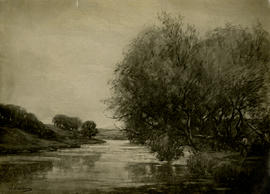Photograph of the Cuillin Hills view painting
- DC 120/2/7
- Item
- c1890s-1920s
Part of Papers and photographs of William Meldrum, artist, student at The Glasgow School of Art, Scotland
A monochrome photograph of a watercolour painting depicting the view of the Cuillin Hills on the Isle of Skye, Scotland. Annotated "Loch Scavaig, The Cuillin Hills from the south" on the reverse, but not dated.
Meldrum, William










